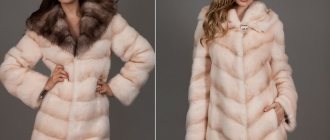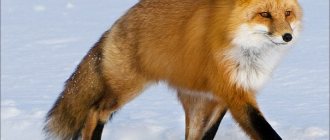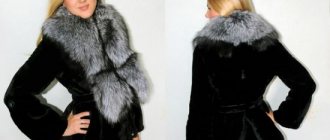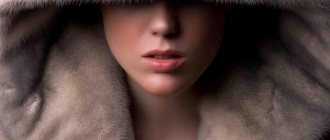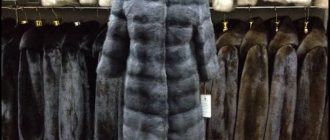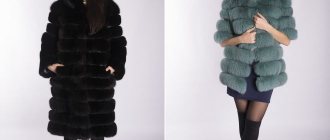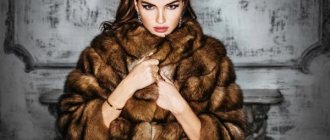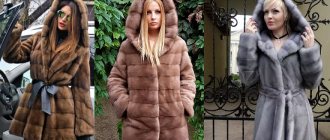Trends are determined not only by styles. An important criterion for the best choice is the fashionable colors of mink coats. They are often determined by the place of origin of the fur, its rarity, and the peculiarities of dressing and selection of skins. Subtleties and nuances known only to designers and true fur connoisseurs should not be a secret for a true fashionista.
Moreover, the rules for choosing a good fur coat color differ significantly from the rules for choosing ordinary things. Just knowing your own color type is not enough.
Here you will find out the names of the fashionable shades of mink coats, you can see their photos and read a description of each color.
Black mink coats and photos of graphite-colored models
To begin with, it is worth clarifying that all colors are considered relevant today - from coal-black Blackglama to numerous shades of white. Light shades not only allow you to reveal the style; it is not without reason that the most luxurious models are made from light-colored furs. They allow you to show all the beauty and nobility of the fur itself.
Of course, no trend can dislodge Blackglama - this is one of the most recognized and popular furs of natural black color, sometimes with a reddish tint - it is also called the “color of oil”. But the fact is that the popularity of this fur also has a downside. It is often counterfeited, inexpensive models are made from fakes, and therefore it is not surprising that black fur is an overly popular option.
But you really want your own fur coat to be unique. In defense of the real American Blackglama, it is worth saying a few words. Fur is indeed luxurious and expensive, but if you choose this shade, choose the most complex, designer style.
When deciding which color is best for a mink coat, first of all, you should not go to extremes. Just like shades of black, all snow-white tones are also very insidious, primarily due to impracticality and excessive expressiveness. Things that are too bright tend to quickly bore their owner. But within the boundaries of these colors lies a whole range of magnificent natural shades, among which you can choose your own and unique one. But first, you shouldn’t destroy the image you’ve created over the years and choose a fur shade just because it’s in fashion. To make the fur really suit your face, use the color scheme that you usually stick to – without drowning it out, but without depleting it either.
Carefully study all the shades that suit your personal color type, there are many options, even among the popular ones, very dark shades. Look how impressive the graphite-colored mink coat is in these photos:
Mink coats in mahogany and walnut colors (with photo)
For example, the color of a mink coat “mahogany” is a classic of fur fashion. The shade got its name due to the rich tones characteristic of redwood species growing in South America.
The rich dark beard-brown tone of the fur is the result of many years of selection, and it’s not just about beauty. This type of fur is rightfully considered the warmest and can withstand very severe frosts. There is one small “but” - the price for natural “mahogany” can be significantly higher than for any other fur. But it justifies it in full, the fur is not only warm, but also almost eternal.
A more delicate shade of brown is “walnut”; the color of this mink coat is closest to the natural shade of the fur. By the way, almost half of all fur coats in the world are made from it, but it also has its own subspecies and characteristics.
For example, Finnish mink fur (scanglow mink) has a very beautiful shade of hot chocolate.
Scandinavian brown mink is labeled (demi buff) - it is a beautiful rich nutty tone of medium intensity.
Of particular interest are two exclusive subspecies of this fur. “Walnut-mahogany” is a rich and bright, as well as rare and, therefore, expensive walnut-marble fur: light brown with a chocolate tint. You can choose your own shade from such a variety to suit any color type; it’s not for nothing that brown-walnut shades are considered universal. Unlike too dark tones, they do not add unwanted age and solidity, but at the same time they have all the advantages of dark furs and can be successfully combined into any wardrobe. A walnut-colored mink coat like the one in the photo is an example of style and elegance:
Fashion trends 2021
Its trendiness also plays a significant role in the appearance of a sheared mink fur coat. Today fashion designers offer a wide selection of styles and cuts. The color range has also expanded, and unusual methods of dressing and cutting fur have appeared. In 2021, the following models became the most popular:
- Classic. They decided not to completely exclude her from fashion collections. After all, it goes so well with any other style of clothing, always remains relevant and looks elegant.
- A-silhouette. He's running the show now. The fashion for fur coats, extended at the bottom, did not bypass the fashion. In 2021, fashion designers decided to complement the elegant A-line silhouette with an original “zest” - they widened the sleeves and highlighted them with color.
- Fur coats-robes and fur coats-dresses. An incredibly feminine option - fitted, with a belt and a widened hem.
- Cocoon. A more free and democratic style. It allows you to create unusual images. After all, sheared mink, wide at the waist and narrowed at the bottom, is not the most trivial option for a fur product.
- Wide collar or no collar at all. A large folding collar that completely covers the shoulders is another trendy novelty from the designers. As well as models in which there is no collar at all.
In terms of palette, the most fashionable were natural and neutral shades, close to nature. All shades of chocolate, gray-blue tones and bright “multicolor” have become no less relevant.
Useful materials:
- Cutaneous horn General description of the disease Cutaneous horn on the forehead or face (ICD 10 code - L57.0) -...
- Itching and odorless discharge Main causesBefore considering the factors that provoke the appearance of discharge that has a sour odor, it is necessary to immediately note...
- Normal temperature in animals Normal temperature in different types of animals Veterinary services Day hospital for animals Veterinary certificates Vaccination…
- Discharge in women What kind of discharge between menstruation is considered normal? Female discharge normally consists of mucus from the cervical canal, dead...
Mink coat colors: mocha and cappuccino
Brown mink coats are a constant fashion hit. Suffice it to remember that brown itself has about fifty original shades, and fur manufacturers quite actively use this rich range. Today it is fashionable to depart from the classical canons, while maintaining the highest standards of both design and natural fur color.
A great example is a mocha mink coat. The intense yet delicate shade gets its name from, of course, coffee. There can be as many shades of fur as there are varieties of coffee itself. Soft gradient color transitions - from soft brown to golden - look great, both in the original, uncut form, and with any type of modern processing. Perhaps this is why designers love “mocha” so much, creating both original and classic, almost standard models from it.
Fur looks great in shortened models, such as peacoats and parkas, as well as very short ones, which are called “autolady”.
A cappuccino-colored mink coat also has a similar “coffee” name. This is the same as “mocha” universal, and at the same time luxurious fur, which allows you to accurately create a respectable and at the same time modern image. The fashionable colors of mink coats in these photos are a reflection of the latest trends:
Variations on the theme of texture
Color is color, but today designers are doing their best to change the texture of mink fur. The most common types of fur processing are plucking and shearing. When pinched, the guard hair is removed, but the velvety underfur remains unchanged. When shearing, the spine is shortened, but if you run your hand over the skin, especially against the grain, you will feel a tingling sensation. Most often, a combination of plucking + cutting technologies is used.
“High” mink processing technologies have become widespread in recent years. Among them are laser burning, in which patterns of hair of different heights are applied to the fur, as well as through perforation. Particularly popular is the finishing of the mesh to resemble leather and suede for mink sheepskin coats.
The triumph of technological processing of elite animal fur occurred at the beginning of the millennium. When using a carefully thought-out combination of all technologies, it is possible to obtain a material that is completely different from fur. Modern dressing technologies even make it possible to level out the “historical” difference in products made from female and male mink. However, a product made from males is invariably heavier than a similar product made from females. In this case, the weight is added not so much because of the thickness of the flesh, but because of the number and length of hair. A separate item is fur knitwear, created using weaving technology using a special elastic mesh base.
Mink coats - “cross sections” in sable color (with photo)
One of the most tempting and interesting shades of brown is represented by models made from sable mink fur. This is not a fake or fiction, but a special type of fur and even the assembly of the model. Sable fur is one of the most expensive in the world; these animals are not bred in captivity, hence the exclusivity and price. No wonder he is called the king of wild fur.
But there are varieties of mink – the best are considered Scandinavian and Russian – whose fur perfectly imitates precious sable. The skins are a delicate chocolate color with beige stripes along the edges and have a thick and fluffy pile. Models made from such fur are never assembled “lengthwise”.
The desired “sable color” is given to a mink coat by a “cross stitch,” that is, an assembly in which the skins are sewn together horizontally. As an option, such models are complemented with narrow transverse strips of leather. In any case, you get a very impressive and exclusive fur product. Mink coats of sable color, such as those in the photo, are real works of art:
Which mink fur is best?
On sale you can find mink fur of various origins: Russian, Scandinavian, North American and Chinese. Mink fur can have different qualities depending on the growing conditions and diet of the animals. Today, minks are bred in many countries: Russia, Canada, USA, Finland, Scandinavia, Poland, Holland, the Baltic states and China.
Russian mink
The Russian mink was bred in 1928 in the Soviet Union to produce warmer fur to produce coats that could be worn in the harsh Russian winter. Today, long fur coats are most often made from Russian mink.
This fur is actually quite different from Scandinavian and North American fur due to its high undercoat and longer hair. Products made from Russian mink are a little shaggy, but they are absolutely not afraid of moisture, frost and are very, very warm. Russian mink has a beautiful shine and is highly silky.
Contrary to popular belief, Russian mink is bred not only in Russia. The Belarusian and Baltic mink are subspecies of the Russian mink.
Russian mink is half the price of North American mink, despite the fact that the quality, dressing, size and color may be equivalent.
Scandinavian mink
The most common farmed mink on the planet is the Scandinavian mink. It accounts for as much as 80% of the world mink market. It is grown in northern Europe: Finland and Scandinavia.
Scandinavian fur is distinguished by a very thick undercoat and medium-length pile, although there are several varieties of Scandinavian mink. There is both low fur (Denmark, Kopenhagen Furs) and high fur (Finland, Saga Furs).
Another variety of Scandinavian mink is the “polar” mink. This is a brown mink with a very thick undercoat and long fur that looks more like a sable than a mink.
Finnish mink (Saga Furs), as mentioned above, is distinguished by long pile and not very thick undercoat. This is an auction fur that is bought at the Finnish Furs Sales in Helsinki. Skins in perfect condition are designated Saga Royal Mink, skins of good quality are labeled “Saga Mink”. The quality of the fur is determined through a rigorous selection process - out of one and a half million skins, only three thousand will receive the title of Saga Royal Mink, and ten thousand Saga Mink. As you understand, the prices for such elite fur are very, very high.
Danish mink (Kopenhagen Furs) has a lower pile. From this manufacturer you can find different selections: short-haired “corduroy”, as well as Danish mink with taller fur. Fur from Kopenhahen Furs is one of the most wearable and lightest. It has a wide color spectrum. Danish auction Kopenhagen Furs offers various markings for skins. Kopenhagen Purple is the highest quality, Kopenhagen Platinum is the highest grade mink, Kopenhagen Burgundy is medium quality, Kopenhagen Ivory is the lowest quality.
Mink coat colors: beige, pastel and powder
What do words like “sapphire” and “topaz” tell you? Of course, these are precious stones, but not only - these are also shades of fashionable mink coats in pastel colors. There are many of them in modern fashion, ranging from champagne shades to cocoa and palomino tones.
“Palomino,” by the way, is one of the most refined and delicate shades, very popular in new trends.
The peach-beige color of such mink coats allows you to demonstrate the richness and beauty of the fur texture. It is neutral and at the same time rare, and looks aristocratic both in classic models and in the most avant-garde ones.
Light shades are always elegant; this quality is not overlooked by designers who feature models in colors that are not typical for a practical winter wardrobe.
Such as powder-colored mink coats - delicate, slightly smoky and dusty fur with a light pink tint looks like a real jewel.
Fawn mink coats and pearl-colored models
A fawn mink coat will look a little more conservative, but no less stylish.
The pinkish-beige shade of fur is considered more classic, and meets timeless standards. Impeccable options for the styles of such models are elongated pea coats or beautiful “trapezes”, gathered along the cut lines.
By the way, all light-colored furs (from high-quality manufacturers!) are natural, and not bleached or dyed. But their production is more difficult and costly than ordinary dark ones. Therefore, the high price, for example, of a pearl-colored mink coat is justifiably higher than many others.
"Pearl" gray mink coats
The pearl shade is considered truly rare in the world of fur fashion: a subtle gray tone on snow-white fur complements the beautiful natural shine and shimmer of the pile - truly luxurious fur. It looks very beautiful and creative in models assembled transversely or diagonally, as well as in combination with fluffy snow-white fur - for example, arctic fox.
The gray color of a mink coat can be any of a dozen existing shades. Furriers suggest choosing a shade based on the undertone of the fur; it can be either bluish or white, but the most popular is graphite.
Such models are at the same time universal - unlike most light fur items, they are not so capricious to care for, but at the same time, they always look very respectable and elegant. In addition, gray has been the “new black” for several seasons in a row. And this model will fit perfectly into a fashionable winter wardrobe.
This kind of fur, by the way, is somewhat cheaper than other pastel ones, and is used to make models that are assembled in “plates” to create a single fur fabric. By the way, all gray shades go well not only with classic styles, in which expensive fur looks beautiful. They perfectly highlight trendy styles designed for youth looks.
Cropped parkas or bombers made from this fur are an excellent solution for a youth wardrobe.
In the most daring collections, and therefore forecast for several seasons ahead, today there are practically no models made of snow-white fur. Designers left it for more frivolous styles - boas and stoles. The white color has been actively replaced by pastel colors - complex and diverse.
By the way, such shades have a serious anti-aging effect; unlike dark models, they will visually “subtract” several years from your age.
crushed ice
This is a selective shade of mink. It belongs to bluish tones, and it necessarily undergoes additional processing. Fur is beautiful, effective and is currently very popular. These are pale gray skins with a light underfur, which is discolored to a beige, white color. At the same time, the fur itself remains the same - gray and does not lose its shine, since only the undercoat is discolored. This is a fairly wearable color that is ideal for girls of all ages. It is one of the most popular options.
Fashionable mink coats in natural colors and their photos
There is a huge range of shades, which is easy to get confused even for those who understand fur. Moreover, manufacturers often come up with their own names for the colors of mink coats. This is, in fact, nothing more than a marketing ploy.
Of course, it’s more pleasant to know that your “mink” is a unique “iris” or “stardust” color. Although these are just shades of gray and brown... Such innocent tricks can be forgiven.
But in order to really understand the colors of this fur, it is worth remembering that the natural color of a mink coat can be anything: from white to blue black.
And in this range, both soft coffee and powdery shades are perfectly represented. Even in such a popular spectrum as brown, experts count at least a dozen original shades.
The second thing to remember is that this fur has long been bred on an industrial scale, and it is much more pragmatic to create a new breed than to dye the fur. It is still quite expensive, and painting cheapens the appearance and reputation of products made from it.
Dyed mink coats in blue and light blue
From time to time, tinted and even painted models appear in trends.
For example, such as a blue mink coat - original and, of course, unforgettable. But what is worth considering when choosing such a model. They dye, and at the same time, most often cut the most inexpensive furs, subjecting them to serious chemical treatment. And it’s not even about the environmental friendliness of such fur; any unnecessary impact affects its quality.
This model can hardly be called natural, and it will “live” in your wardrobe for at most a couple of seasons. During this time, it will become fashionable and the quality of the fur itself will make itself felt.
Those who cannot resist exotic shades should pay attention to models made of blue or pinkish fur, it is absolutely natural. Just like the whole pastel range of mink furs. In this case, the art of breeders and furriers plays a role. Such a mink coat of natural color, as in the photo, deserves special attention:
Stylish looks
To look stylish in a mink coat, you need to choose the right accessories for it.
With a product of any length, low-heeled boots with a fur top look impressive. With a short fur coat, you can wear comfortable low-top boots or low boots with a stable small wide heel or a solid sole.
You can put a practical knitted hat, headband, elegant scarf or stole on your head. Those who do not accept hats under any circumstances should choose fur coat models with a hood. They are warm, comfortable and do not spoil the hairstyle at all.
Almost any clothing goes harmoniously with long fur coats. For medium-length products, the following options are suitable:
- jumper and pencil skirt;
- soft knitted dress of a simple cut;
- tight jeans and golf;
- cashmere sweater combined with a skirt or jeans.
With short fur coats of a fitted style, you can wear trouser suits that match the color.
